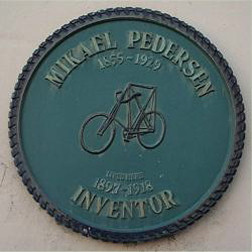

 |
 |
||||||||
| Mikael Pedersen and The Dursley Pedersen Cycle Company | ||||||||
|
The links between the town of Dursley and the Danish inventor Mikael Pedersen began at the end of the 19th century. As described in the history of the R.A.Lister company, Pedersen was responsible for a new design of centrifugal cream separator which provided an efficient means of separating the cream and whey from milk, a problem which people had been trying to overcome for a number of years. Lister gained the British selling rights for the separator which went on to become a huge success for the company and led to Pedersen moving from Denmark around 1893, most probably in order to be more closely associated with its development but perhaps also to escape the limited opportunities for further invention he experienced in his native country. |
||||||||
|
He soon established himself in the town, living in Kingsley House in Long Street and becoming a founding shareholder in R.A. Lister & Company. It was around this time that he began development of an innovative method of cycle construction using lightweight multiple triangulated tubing which he patented in 1894. |
 |
|||||||
| Dursley Pedersen Advertisement - courtesy David Harris | ||||||||
|
Early examples were of wood but by 1896 he had perfected a method of jointing metal for which he again acquired a patent. This frame design, combined with a novel hammock style saddle strung between front and rear resulted in a unique concept. He formed a new company, the "Pedersen Cycle Frame Co. Ltd" with the financial backing of a wealthy American, Ernest Hooley, and moved into a factory in Water Street (the old Pin Mill, recently renovated in 2002) from where he began to produce his new cycles in 1897. In 1898, Pedersen moved into Raglan House in Long Street, in the garden of which he laid out a cycle track which he used to exercise and test his machines. Unfortunately, later that year, Hooley was declared bankrupt, forcing Pedersen to look elsewhere for finance. This came in the form of R.A. Lister who acquired the patent for the cycle, and established a new company, the Dursley Pedersen Cycle Co. to built the bicycles under license from the Pedersen Cycle Frame Co. Ltd. Production gathered pace during the first few years of the 20th century and Pedersen spread his inventive wings, coming up with military versions, ladies and low-cost varieties as well as racers and tandems. |
||||||||
 |
It wasn't all going well though, sales were not as expected and there was criticism of the design from some quarters. Pedersen's new invention, a hub gear, in competition with one from Sturmey-Archer, initially proved unreliable, causing disquiet between the R.A. Lister Co. and the cycle company. Sales suffered further, losses started to mount and in 1905 the Dursley Pedersen Cycle Company was wound up and taken over by R.A. Lister and Co. Ltd. | |||||||
| Plaque on Raglan House, Long Street | ||||||||
|
Following the transfer of assets and liabilities to R.A. Lister, a redesigned gear mechanism and new leadership, Dursley Pedersen cycles began to be produced again and sales rose once more. Mikael Pedersen, however took little part in the venture, concentrating on other avenues, including a new motor cycle using his cycle frame geometry but it was not a success. By 1917, tastes had changed, the world had moved on and the end was in sight and the sale of cycles by R.A. Lister ceased. Four years later, all stocks of parts were sold to a London firm who continued selling the cycle for a few years. |
||||||||
|
In 1920, Mikael Pedersen, perhaps disillusioned by the failure of his inventions,
or the breakup of his third marriage, returned to Denmark where he continued
to live in relative poverty, unknown and all but forgotten, until his death
in 1929.
The story is not finally over though. In 1995, following a campaign and collection for funds, Mikael Pedersen's remains were exhumed from their unmarked grave in Denmark and re-interred in Dursley cemetery. Over 300 people attended, including family descendants, local dignitaries and enthusiasts of the unique cycle which still has its followers, even in 2003. |
 |
|||||||
| Pedersen Headstone in Dursley Cemetery | ||||||||